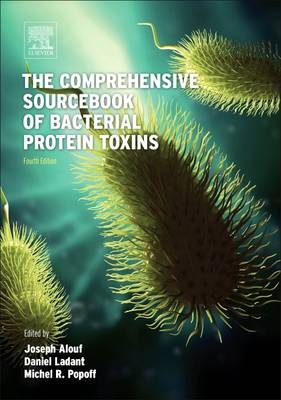
The Comprehensive Sourcebook of Bacterial Protein Toxins
Elsevier Science Publishing Co Inc (Verlag)
978-0-12-800188-2 (ISBN)
Joseph E. Alouf is Professor of Microbiology at the Pasteur Institute of Lille. He is former Head of the Department of Bacteriology and Mycology at the Pasteur Institute at Paris and Chairman of its Scientific Council. He served as Secretary General of the French Society of Immunology from 1984-1986 and President of the Federation of the European Microbiological Societies from 1989-1992. His 40-year research work relates to the field of bacterial protein toxins and immunology of infectious diseases. He is also the co-editor of several books. Daniel Ladant is Director of Research at French CNRS (National Center for Scientific Research) and head of the “Biochemistry of Macromolecular Interactions unit at Institut Pasteur, Paris, France. He obtained a Ph.D. in Microbiology in 1989 and a « Habilitation à Diriger des Recherches » (HDR), in 1999 from the Université Paris Diderot, Paris, France. His research has been mainly focused on the study of the molecular mechanisms that underlie protein-protein and protein-membrane interactions, using as a model system a bacterial toxin, the adenylate cyclase (CyaA) produced by Bordetella pertussis, the causative agent of whooping cough. CyaA is an essential virulence factor from B. pertussis, and belongs to the large family of RTX (Repeat in ToXins) cytolysins produced by diverse Gram-negative bacteria. By combining molecular genetics, biochemical and biophysical approaches, he has characterized the structure, function and biogenesis of the CyaA toxin, with a particular emphasis on deciphering the molecular basis of its original entry pathway that involves a direct translocation of its catalytic domain across the plasma membrane. Basic knowledge gained on the mechanisms of CyaA entry into eukaryotic target cells and its interaction with cellular effectors has been used to develop various applications in vaccinology and biotechnology. In particular, the natural property of the CyaA toxin to target immune cells has been exploited to create innovative vaccines capable of stimulating potent cell-mediated immune responses against specific antigens. Two CyaA-based recombinant vaccines are currently evaluated in clinical trials. D. Ladant also designed a CyaA-based two-hybrid (BACTH) technology that has been exploited for studying, in bacteria, the assembly of protein complexes, and particularly to analyze membrane associated machineries such as bacterial secretion systems or the bacterial cell division apparatus. His other research interests include the other class II bacterial adenylate cyclase toxins, such as Edema Factor (EF) from Bacillus anthracis and ExoY toxin from Pseudomonas aeruginosa, in particular to explore of the allosteric mechanisms implicated in the activation of these enzymes by eukaryotic factors. He has published more than 90 articles in peer-reviewed journals, 20 review articles or Book chapters and co-authored 11 patents. Michel R. Popoff, D.V.M., Ph.D. (Microbiology) from the University of Paris (1985), Habilitation à Diriger des Recherches (HDR) from the University of Paris (1990), is the Head of the Anaerobic Bacteria and Toxins Unit and the Director of the National Reference Center for Anaerobic Bacteria and Botulism at Pasteur Institute, Paris, France. He is member of the French Veterinary Academy. His laboratory is focused on Clostridium toxins through genetic and biological activity analysis and has investigated the regulation of toxin synthesis in Clostridium botulinum and Clostridium tetani. In the recent years, we have analyzed the molecular mechanism of the actin depolymerizing C. sordellii lethal toxin and clostridial binary toxins, the pore-forming C. perfringens epsilon toxin, and the passage of botulinum neurotoxin through the intestinal barrier. He was co-editor of the 3° edition of the Sourcebook of Bacterial Protein Toxins Academic Press (2006).
Section I: Basic Genomic and Physiological Aspects of Bacterial Protein Toxins1. Evolutionary aspects of toxin-producing bacteria2. Mobile genetic elements and pathogenicity islands encoding bacterial toxins3. News and views on protein secretion systems
Section II: Intracellularly Alive Bacterial Protein Toxins4. Diphtheria toxin5. Pseudomonas aeruginosa toxins6. Bordetella protein toxins 7. Vibrio cholerae and Escherichia coli heat-labile enterotoxins and beyond 8. Vibrio parahaemolyticus virulence determinants 9. Typhoid toxin10. Shiga toxins: properties and action on cells11. Clostridial neurotoxins: from the cellular and molecular mode of action to their therapeutic use12. Uptake and transport of clostridial neurotoxins 13. Bacillus anthracis toxins 14. ADP-ribosylating toxins modifying the actin cytoskeleton 15. Large clostridial cytotoxins modifying small GTpases: structural aspects 16. Large clostridial glycosylating toxins modifying small GTPases: cellular aspects 17. Pasteurella multocida toxin 18. Deamidase toxins 19. Helicobacter pylori vacuolating toxin 20. Bacterial genotoxins
Section III: Bacterial Protein Toxins Active on the Surface of Target Cells 21. Basic mechanism of pore-forming toxins 22. Membrane-damaging and cytotoxic sphingomyelinases and phospholipases 23. Structure and function of RTX toxins 24. Perfringolysin O and related cholesterol-dependent cytolysins: mechanism of pore formation 25. The staphylococcal alpha-toxin and leukotoxins 26. Aerolysin and Related Aeromonas Toxins 27. Structural relationships between small ß-pore-forming toxins from Clostridium perfringens 28. Clostridium perfringens enterotoxin 29. Bacillus cereus phospholipases, enterotoxins, and other hemolysins 30. Mechanism of action of Bacillus thuringiensis insecticidal toxins and their use in the control of insect pests 31. Escherichia coli heat-stable enterotoxins 32. Bacterial superantigens and superantigen-like toxins
Section IV: Clinical Aspects, Applications of Bacterial Protein Toxins in Cell Biology and Therapy, and Toxin Inhibitors 33. Clostridial toxins in the pathogenesis of gas gangrene 34. Engineering of botulinum neurotoxins as novel therapeutic tools 35. Engineering of bacterial toxins for research and medicine 36. Toxins as tools 37. Exploiting endocytic pathways to prevent bacterial toxin infection 38. Inhibitors of pore-forming toxins 39. Bacterial protein toxins as biological weapons
| Sprache | englisch |
|---|---|
| Maße | 152 x 229 mm |
| Gewicht | 1390 g |
| Themenwelt | Studium ► 2. Studienabschnitt (Klinik) ► Pharmakologie / Toxikologie |
| Naturwissenschaften ► Biologie ► Biochemie | |
| Naturwissenschaften ► Biologie ► Ökologie / Naturschutz | |
| ISBN-10 | 0-12-800188-7 / 0128001887 |
| ISBN-13 | 978-0-12-800188-2 / 9780128001882 |
| Zustand | Neuware |
| Haben Sie eine Frage zum Produkt? |
aus dem Bereich


